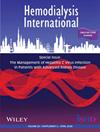Unveiling Challenges Hindering the Growth of Home Dialysis in Finland: Insights From 40 Years of Experience
Abstract
Introduction
Home dialysis has been associated with better patient survival compared to in-center hemodialysis. Finland has over 40 years of experience with home dialysis. Despite sustained efforts, the prevalence of home dialysis has decreased in the last decade. We aimed to explore the barriers to expanding home dialysis treatments from healthcare providers' and patients' perspectives.
Methods
This is qualitative research, based on an electronic semi-structured survey directed to nephrologists, nephrology nurses, and patient associations. The survey development contemplated the main barriers shown in a conceptual framework described previously in the literature. An open-ended question was analyzed using the content analysis method.
Findings
All participants agreed that the nurse shortage and patients' several comorbidities are the main barriers. Healthcare teams were perceived as having good qualifications and interest in home dialysis. Intense transplant activity was not perceived as a barrier. Doctors and nurses believed that starting in-center hemodialysis decreases the odds of switching to home dialysis later, and patients have less motivation or reliability in their abilities. From the patient's perspective, the financial burden and the impact of home dialysis on the assistant or relative constitute critical barriers. Also, bringing hospitals home or living in small spaces is an important barrier to accepting home dialysis.
Discussion
Expanding home dialysis modalities requires boosting the home dialysis nursing pool, choosing home dialysis as a first modality, and removing the financial burden on the patients. While the rise in patients with multiple comorbidities remains unchanged, supporting relatives to prevent burnout could be beneficial.


 求助内容:
求助内容: 应助结果提醒方式:
应助结果提醒方式:


